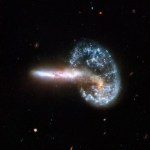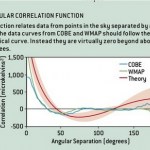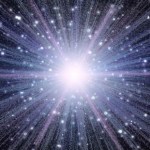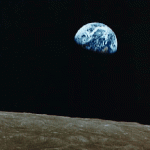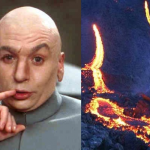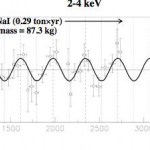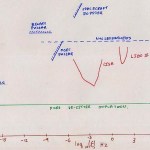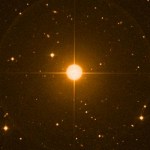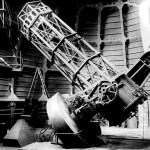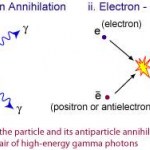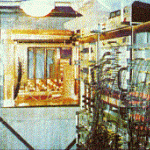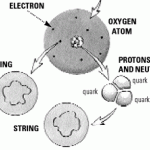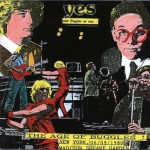
(Thanks to Starts With A Bang! reader benhead.) The Hubble Space Telescope has released some beautiful images of colliding galaxies in a huge collection! Here are some of my favorites, with my very own names for them (real name in parentheses).
We'll start with the Glowing Arrow (Arp 148):
The Highway Windshield (NGC 6240)
The Flaming Splinter (NGC 6670):
And finally, I call this one "my new desktop wallpaper:"
I was going to write a whole bunch about this, but I have been beaten to the punch by Universe Today, Bad Astronomy, and Will Gater. I'll have to wake up earlier next time! In the…
Warning: Crazy talk ahead. Some of you may remember that I wrote about inflation and why its alternatives fail awhile back. Apparently, Louise Riofrio didn't get the memo. When there's misinformation about cosmology out there, it's up to me to set the record straight. (And I am not alone.) Let me first remind you about one of the alternatives to inflation I debunked last month:
Add defects and vary the Speed of Light. This one’s out. Why? Because we would see defects in the Cosmic Microwave Background, and we don’t. The constancy of the speed of light is highly supported by experiments, but…
Since the dawn of time man has yearned to destroy the sun. - C. M. Burns
There's no need to stop at the Sun, though. Since yesterday was Earth day, I thought it was only appropriate to spend today telling you how not only to destroy the Earth, but to effectively destroy the entire Universe. To tell you this story, we have to go all the way back to the beginning, to just before the big bang.
The big bang was when the Universe was hot, dense, full of energy, and expanding very quickly. The Universe was also spatially flat and the same temperature everywhere, and full of both matter and…
As you may have noticed from yesterday's unusual post, today is Earth Day! I thought I'd share with you some of my favorite pictures from space of it, including the famous photograph from Apollo 8 known as Earthrise:
This combination shot made from NASA’s Terra satellite and NOAA’s Geostationary Operational Environmental Satellite:
The known satellites at least 0.1 meters in size in orbit around Earth (there are ~11,000 of them as of April 2005, and another 100,000 between 1 cm and 10 cm in size):
Looking at the Earth and the docked Space Shuttle from the International Space Station:
And…
What makes earthquakes? Although there are many causes, including volcanoes, the most common thing that causes them are tectonic motions, which also cause tsunamis. But as valuable as it is to understand other planets in our solar system and in other star systems, sometimes it's important to understand what's going on inside our own planet.
The crust of the Earth actually is made up of a number of plates, which rub against one another and move over time. Who's to blame? I fault the liquid hot magma.
So what happens is that these plates slip against each other in one of three ways, as shown…
Sometimes, gravity and motion has the power to mesmerize me. I found this online game called "compulse" which was so much fun, that I spent about 90 minutes this week just playing this game until I had beaten every level on the "pro" setting. Yikes. (My score is 104 under par, 8 under pro.)
And so, in the interest of bringing it to you, I've tried to embed it into my website. Have fun playing if it works in your browser (I told you to use firefox or safari), and if you enjoy playing with the mechanics of motion as much as I do, maybe you, too, have the interest it takes to be a physicist!…
Remember how I told you earlier this week that DAMA was going to announce that they found dark matter, even though the signal that they found is not consistent with other experiments?
Looks like my powers of predicting the future are pretty damned good. They have a new plot with more data showing the continued modulation at a certain energy range:
and also one showing the fact that they see a bunch of extra events happening in that energy range:
So here's the stuff that DAMA has seen: a nuclear recoil that has many events in a certain energy range, and has a 2% annual modulation in that…
Bret Underwood, a friend of mine from my time in Madison, WI, saw my post on String Theory, and took issue with my statement that it wasn't testable. I'm still standing behind what I said, but let's address what Bret has to say.
I donât understand your argument above for why string theory is untestable. In fact, it seems to me you just outlined the best possible case for string theory! What you said above is that if I have a string theory construction of a phenomenon (say, the Standard Model or Inflation), which uses a set of parameters X, and makes some predictions, then I can find another…
What is the future of this website? I'm going to be creating videos for the web about the Universe. I'll be answering questions ranging from what the Universe is like today to how it got to be that way. I'm going to address every step that we know of, from the Big Bang up to the present day.
And I'm going to do it naturally, by telling the story as the Universe tells it directly to us. I call this project Genesis. Check out the teaser trailer below, and tell your friends, because this is coming in January.
Nothing gets past you, does it? A scientific paper came out earlier this week, and I took a look at it, sighed, and Jamie asked me, "What?" And I said to her, "When I see bad science, it just makes me a little bit frustrated and sad." Of course, I had no intention to write about it.
But then Starts With A Bang reader Matt emailed me, and writes the following about this press release that he had seen:
You have two explanations for these gravitational waves now and that much I understand. But they make it sound as if symmetry breaking and inflation are competing theories. They aren't, right? Do…
Ahh, stars. Giant furnaces of nuclear fusion. Doing the stuff our Sun does, burning hydrogen fuel into helium (among other things) and emitting lots of visible light and energy in the process.
But when we take a look at brown dwarfs, they aren't like normal (i.e., main sequence) stars like our Sun. Instead of burning hydrogen into helium for their fuel, brown dwarfs don't generate enough pressure to make that happen; they can only burn hydrogen into deuterium.
Let's go over what the differences here are. A hydrogen nucleus is just a proton, with a mass of 938.272 MeV/c2. (I use these units…
...just bring your own air and water. The BBC is reporting that the European Space Agency has determined that Marigolds, when planted in lunar soil, would be able to grow without adding any extra nutrients.
How cool is that?
I was doing a little research into the history of telescopes, and it was about a century ago that they finally realized how much more potential light-gathering power reflecting telescopes had as compared to the older refracting telescopes. On Mt. Wilson in California, astronomer George Ellery Hale and optician George Willis Ritchey (back then everybody was named George -- look it up!) were embarking on a program to build large reflecting telescopes as the wave-of-the-future of Astronomy.
But even before this telescope was operational, Hale and Ritchey were thinking of bigger and bigger…
Yesterday, my good friend (and SWAB reader) Brian wrote a great comment about the practical reasons to explore space, where he talked about the overall economic impact that Space Exploration has had on the economy, as well as the impact it has had on our knowledge and understanding of the Earth, its environment, and how to manage/mitigate the threats to it. And that's wonderful for exploring our Solar System and others.
But what do I do in the meantime? After all, this isn't what I study or explore. So I asked this:
The practical arguments as to why exploration of space is worthwhile…
The DAMA collaboration, an experimental team searching for dark matter via direct detection, is poised to report this week that they have discovered Dark Matter. And I'm here to pre-empt that by bringing you the truth: no, they haven't.
They take some very cold (cryogenic) atoms,
look for nuclear recoils resulting from dark matter collisions, subtract the background, and draw conclusions based on whatever's left over. Their expectations are based on the following:
Neutrons, neutrinos, and other standard model particles from the Earth, the Sun, and the Milky Way galaxy will collide with the…
Over the past few months, I have been asked a number of questions about String Theory and the Universe, including from readers Benhead and Mastery Mistery. But now Jamie, whom I'm going to marry later this year, has been asking me about it, and so it's time to write something about the scientific topic of String Theory. (Send in your questions now, because I'll answer them all this week if there's enough interest.) Let's start with this pair of questions:
String theory has been around for over 20 years, and so far, there is not one shred of experimental or observational evidence in support of…
Nothing to do with astronomy or physics (except for the perils of gravity), but this TV show is hilarious: Ninja Warrior. I don't get the channel G4 here in Tucson with expanded cable, but this is basically the Japanese version of the American Gladiators event: The Eliminator! If you have some time to waste, watch it sometime. The contestants and the annoucers are hilarious...
Fraser Cain over at Universe Today sent out a question to the Astronomy/Astrophysics/Space communication community today. And he asks:
Why should we spend our time/money/resources on exploring space when there are so many problems here on Earth?
This is something that, for better or worse, I had a knee-jerk reaction to. Here's what I wrote back to him:
This is like asking why we should spend money on making our city better when there are so many problems here in our own homes. Or why we should spend money on understanding our whole world when there are so many problems here in our own…
So, what's the deal with this one? startswithabang.com reader Scott Stuart asks the following question:
I was reading "The First Three Minutes" last night and came across an
interesting section about blackbody radiation and energy density. The
author states that as the universe expands, the number of photons
running around (in the CMB, for example) is unchanged, but their
wavelengths get stretched. The energy in a photon is, of course,
inversely proportional to its wavelength, so the energy content of a
photon decreases as its wavelength increases. That seems to mean that
the total energy…
In my mind, and in my car,
we can't rewind, we've gone too far,
pictures came and broke your heart,
put the blame on VTR.
And for those of you who are under the age of 25, VTR stands for Video Tape Recorder. This was the Buggles, who made the first music video that ever appeared on MTV, back when MTV played music videos. (I wonder what the last music video on MTV was? My guess is California Love by Tupac and Dre back in 1996. At least, that's probably the last music video that I've ever seen on MTV.)
But why all this? Because I wanted to tell you about my appearance on The Space Show this…
